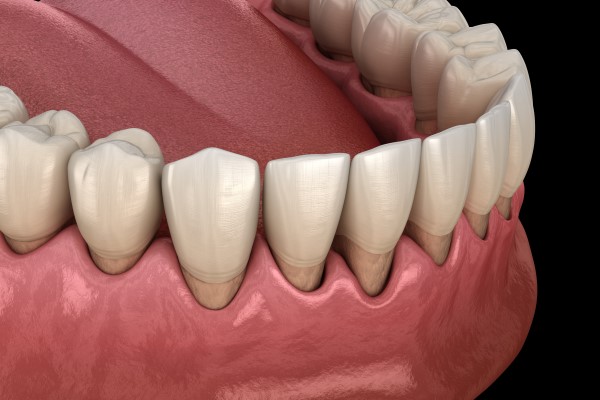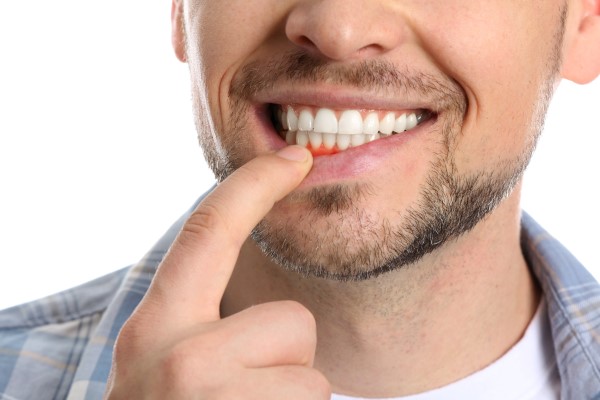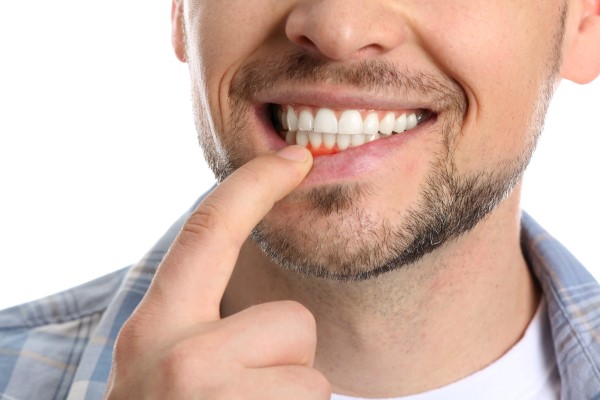Gum Disease Gladstone, MO
At Gladstone Family Dental And Implants, we work diligently to prevent gum disease in our patients. Gum disease is a common condition and most adults will suffer from some form of gum disease during their lifetime. The challenge is that gum disease can lead to bone and tooth loss, making it incredibly important to both prevent and treat it. If you live in Gladstone or the surrounding area, we can examine you and let you know if you are showing any signs of the condition, along with making recommendations for how to prevent it. To schedule an appointment, call (816) 559-7943.
Causes of Gum Disease
There are several reasons that gum disease develops. The primary causes are plaque and tartar. Anything that becomes stuck between your teeth, gums or under the gum tissue, can cause irritation and swelling. Plaque is a problem that everyone deals with; however, it is the buildup under the gums that really causes issues. There are other risk factors to consider like pregnancy, diabetes, and smoking, since they restrict blood flow to the gums, causing them to swell.
Ways to Prevent Gum Disease
We recommend doing what you can to prevent gum disease so you do not experience discomfort or additional health problems. One of the best ways to prevent this condition is to keep your teeth clean. At Gladstone Family Dental And Implants, we encourage our Gladstone patients to brush their teeth two to three times a day and to do so in a circular pattern, moving food particles and plaque away from the gums toward the center of the mouth. You also need to floss on a daily basis, and be sure to reach all the way down, rather than stopping at your gum line. Using an antiseptic mouthwash can also help kill lingering bacteria.
You also need to have your teeth cleaned at least twice per year. It is difficult to remove all of the plaque at home, and tartar is too hard to remove by brushing and flossing. We can remove both plaque and tartar in our dental office and reduce your risk of gum disease. Simultaneously, we recommend that you stop smoking, keep your blood sugar under control, and drink plenty of water, since this can also help improve your gum health.
Common Signs of Gum Disease
Some of the most common signs of gum disease are:
- Red and swollen gums
- Gums that bleed when brushing, flossing, or eating anything crunchy
- Teeth that appear to be getting longer, since this is a sign of gum recession
- Loose teeth
If you notice any of these symptoms, we recommend that you call 816-559-7943 to schedule an examination with our dental office.
Treatment Options for Gum Disease
There are several ways to treat gum disease, and what we recommend will be based on how far the condition has progressed. To start, we typically recommend that our patients have a standard teeth cleaning. If you are only at the beginning stages of the condition, that is likely all you will need to return your gums to good health. However, if the condition has progressed further, you may need a dentist to provide you with the following:
- Periodontal infection therapy. This is a therapy where chemicals are used to slow the growth of gum disease. In this case, your dentist may prescribe the use of an antiseptic mouth rinse, designed to reduce or fight gum disease. Used daily, it can work to kill bacteria.
- Deep cleaning. A deep cleaning is typically conducted in four appointments. Your mouth is broken up into quadrants, with each area being cleaned on a different day. In a deep cleaning, the gums need to be pulled away from the teeth so a dentist can scrape off the plaque and tartar underneath the gum tissue. Naturally, this procedure can cause discomfort, which is why it is completed over multiple visits. However, some dentists use lasers, which can expedite the process.
- Gum grafts. If your gums have receded and too much of your teeth or roots are showing, a gum graft may be necessary to restore the gum tissue back around the teeth. This can be done by suturing tissue from the roof of your mouth to your gums or using tissue from a donor. In both cases, the gums will be secured back around your teeth, like they were prior to you developing gum disease.
- Antibiotics. Very often, your Gladstone dentist will prescribe antibiotics to be taken in combination with gum therapy. This is done to eliminate any infection that could be lingering.
Check out what others are saying about our dental services on Yelp: Gum Disease Gladstone
Why You Could Need a Bone Graft Following Severe Gum Disease
Severe gum disease can drastically and negatively impact your oral health. As gum disease progresses, your gums will swell and then begin to recede or pull away from your tooth structure. This is problematic because the more of your teeth and roots that are exposed, the more likely it is that bacteria will begin to attack them. Simultaneously, your jawbone can also be negatively impacted and begin to lose its density.
If you do suffer from bone loss, you may need a bone grafting procedure. During a bone graft, we place synthetic bone in the area where you experienced loss to encourage bone growth. This can be a necessary procedure when you have experienced enough bone loss to negatively impact the health and stability of your other teeth or the appearance of your face. Whether or not this is necessary is highly dependent on what your X-rays show. However, if you identify signs of gum disease and treat it early, you are likely to prevent the need for this procedure.
Schedule an Examination With Our Gladstone Dental Office
If you suspect that you may have gum disease because your gums are red, swollen, or receding, call our dental office right away. At Gladstone Family Dental And Implants, we can examine you, let you know if gum disease is present, and make recommendations regarding how to treat it.
If you live in the Gladstone area, call (816) 559-7943 to schedule your dental exam so that you can remain in good dental health or receive treatment for a current condition.
Questions Answered on This Page
Q. What is the cause of gum disease?
Q. What are the signs of gum disease?
Q. What will gum disease do to my teeth?
People Also Ask
Q. Why are my gums receding from my teeth?
Definition of Gum Disease Terminology
- Chronic Periodontitis
- Chronic periodontitis is the most common form of periodontitis, involving inflammation of the tissue surrounding the teeth and pockets forming as well.
- Necrotizing Periodontal Disease
- Necrotizing periodontal disease is an infection that causes lesions to form on the face and other symptoms due to the necrosis of gingival tissues, periodontal ligaments and alveolar bone.
- Periapical Cyst
- A periapical cyst is a pathological cavity, roots of the teeth, that typically has epithelium in the lining and contains fluid or soft matter.
- Periodontal Disease
- Periodontal disease is a serious inflammation of the gingival tissues and the periodontal membrane of the teeth that causes pain and helps form deeper gingival sulcus.
- Periodontal Ligament
- Periodontal ligaments are a group of tissue fibers that help attach the tooth to the alveolar bone, which can sustain damage from gum disease or improper oral hygiene.
- Periodontal Pocket
- A periodontal pocket is a potential area of space, known as a gingival sulcus, which is deeper than normal and can contain bacteria that cause an infection.
- Periodontal Surgery
- Periodontal surgery is the treatment of extreme levels of periodontal disease that can involve multiple techniques to remove the inflamed tissue and infection before it spreads.
- Scaling and Root Planing
- Scaling and root planing is a non-surgical therapy that involves the removal of dental plaque in hard to reach places with patients who do not take proper care of their teeth.
Back to top of Gum Disease




